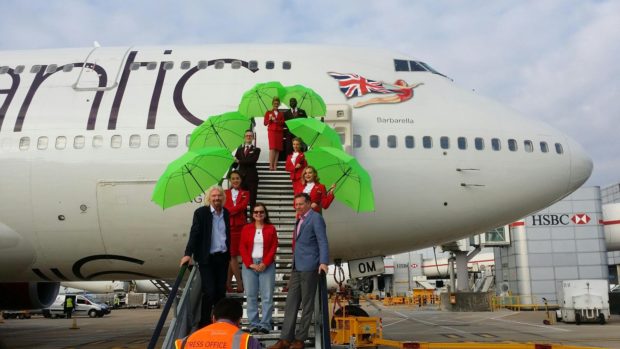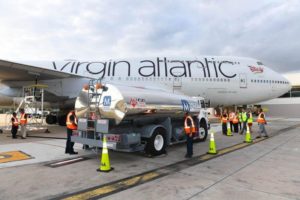We have much more to do and your continued support is needed now more than ever.
Soaring Sustainability: Historic Flight on Low-Carbon Jet Fuel

It isn’t too often that I can get inspired by an airplane journey these days – I travel too much and it’s usually too uncomfortable and annoying. But on Tuesday night, I had the privilege of joining a super fun flight that should prove to be an important moment in aviation history: the first commercial flight (by Virgin Atlantic from Orlando to London) on a fuel mix containing “biofuel” made (by LanzaTech) from recycled waste industrial gases. Virgin’s founder, Sir Richard Branson waved the plane into its docking stand and I got a hug from the flamboyant entrepreneur after landing!
Branson spoke excitedly about the future of this totally new approach to biofuels, and I have to agree with him. Here is evidence that the commercial aviation industry can make a product that actually helps to solve the climate crisis. And Jennifer Holmgren, the farsighted and inspirational CEO of LanzaTech, has her eye on even bigger and better things to come.

This advanced fuel is made out of carbon monoxide pollution from steel production, which is fed to bacteria that consume the carbon monoxide and excrete ethanol. Once excreted by the bacteria, the ethanol is converted into high quality jet fuel (called a “drop-in fuel” because it doesn’t require any changes in the jet engines).
Partnering with Virgin Atlantic, along with the Boeing Company and key financial backers, this flight proved that LanzaTech has invented something really new, and is solving several problems at once: they are producing an advanced alternative fuel that avoids use of agricultural cropland or forests, with no contamination of water resources — so they don’t threaten wildlife habitat — and they are also reducing carbon pollution.
Recent calculations show that this is a low carbon fuel, with at least a 70 percent reduction compared to conventional fossil-based jet fuel. And if the LanzaTech technology were rolled out to all the steel mills for which it is suitable (65 percent of the world’s mills), this could fulfill about 20 percent of the fuel demand of the entire global commercial aviation fleet. Today, LanzaTech is using carbon monoxide from the steel industry to make fuel, but it is also working on other innovations, like recycling different forms of carbon pollution from other heavy industries into long-lived plastic products to permanently sequester the carbon.

The ethanol for Tuesday’s flight was produced at a demonstration-sized facility attached to one of the world’s largest steel mills, at Shougang, in China. This plant was certified for environmental and social safeguards under the global standards set by the member-based Roundtable on Sustainable Biomaterials (www.rsb.org). These standards require the facility to be checked by an objective auditor for impacts on wildlife, water, labor and human rights, and all the other hallmarks of sustainability. (Full disclosure: I was chair of the board of directors of the RSB for some years, and NWF is one of its founding members.)
Biofuels and Wildlife
National Wildlife Federation became involved with biofuels about a decade ago because of a paradox – while biofuels were being touted as potentially reducing climate change pollution, the first generation of feedstocks was all made from agricultural crops, and global expansion of agriculture was already one of the greatest drivers of deforestation and threats to wildlife and habitat. Monarch habitat has been decimated throughout the center of the U.S., as prairie has been cleared and planted to corn for ethanol. The Prairie Pothole region encompassing parts of the Dakotas and Minnesota has been the hardest hit by agricultural conversion during the ethanol boom, yet this region and its vast array of seasonal wetlands are essential breeding grounds for 60 percent of North America’s ducks and other waterfowl. Globally, we were concerned about the growing pressure on jaguars in South America, primates in Africa, and specifically orangutans in Southeast Asia, where agricultural expansion into forests was already underway for food production.

Meanwhile, alternative fuel sources that are compatible with wildlife — such as harvesting native grasses or recycled plastics or even the waste gas/bacteria system utilized by LanzaTech — have either failed to take off or are excluded from the U.S. biofuel program. Even more concerning, it has become clear that not all biofuels even provide a significant greenhouse gas reduction benefit.
That’s why we helped to establish the Roundtable on Sustainable Biomaterials, to provide market incentives to favor “the good stuff,” like LanzaTech’s fuel, instead of corn ethanol. In addition, that’s why the National Wildlife Federation supports the “Greener Fuels Act,” which was introduced earlier this year in both the House and the Senate. The bill would re-orient the U.S. law that regulates biofuels away from its current focus on first generation biofuels, and establish a new framework to allow truly advanced alternatives, like LanzaTech, to succeed. It also seeks to stem the biofuels program’s unintended consequences on land, water, wildlife, and the climate, and establishes new funding for private land conservation and restoration.
NWF’s central concern is that more than 1/3 of America’s fish and wildlife species are at risk of extinction in the coming decades, chiefly because of habitat loss, pollution and climate change. Since about 1980, over 58% of the populations of the world’s vertebrate wildlife species has vanished – it’s a stunning loss.
All sorts of varied solutions will be needed for the world to reverse these losses and begin moving in the right direction – to both conserve natural areas from agricultural and industrial expansion and stop global warming pollution. One example of the necessary solutions was demonstrated here, by LanzaTech and Virgin Atlantic, showing that both conservation and global warming prevention goals can be advanced at the same time.
It is encouraging that the LanzaTech fuel has passed all the technical tests and is demonstrated to work – and is now in the process of scaling up. Their first commercial-scale plant is just getting up and running at Shougang, and new plants are expected to be built at mills in Belgium, India, South Africa and California. An idea that was until very recently only a gleam in a scientist’s eye is on the way to making a really big difference!
Barbara J. Bramble leads the National Wildlife Federation’s advocacy to improve U.S. international policy on climate change and builds business consensus to sever the connection between agricultural expansion and loss of wildlife habitat. She serves on the board of the Forest Stewardship Council—the global eco-label for wood/paper products from sustainably managed forests—and is the former board chair of the Roundtable on Sustainable Biomaterials, which certifies biomass, biofuels, and bioplastics that meet global social and environmental standards. Read more.
As a consumer, you spend a lot of time choosing between an innumerable amount products and services every day. Be a friend to incredible species around the globe, and take the pledge to be a wildlife-friendly consumer:
PLEDGE




















